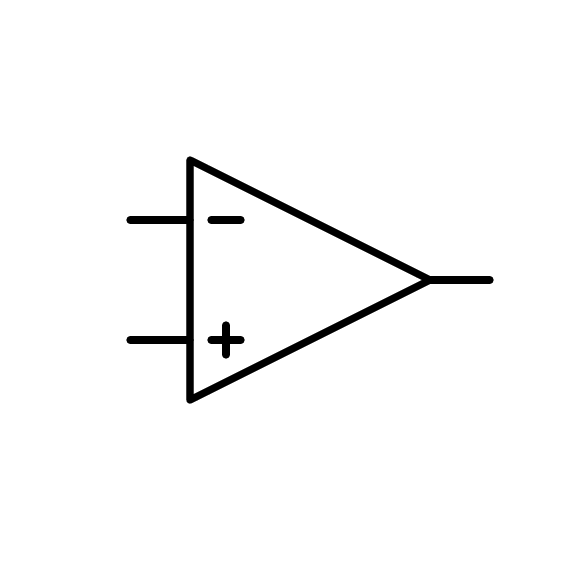15. The operational amplifier¶
The operational amplifier is an electronic circuit composed internally of multiple stages of transistors connected to achieve a differential voltage amplifier circuit, with high gain and as ideal as possible.

Ideal operational amplifier symbol.¶
An operational amplifier has two differential inputs marked with the symbols + and - and one output at the tip of the triangle.
Real operational amplifiers also have two power terminals through which they receive positive voltage and negative voltage, necessary for the internal circuit to function.
- Actual op amp terminals:
- Negative input terminal.
- Positive input terminal.
- Output terminal.
- Positive power terminal.
- Negative power terminal.
Operation¶
The amplifier amplifies the difference between the + and - input terminals. If the positive input + has a higher voltage than the negative input -, the output will have a positive voltage.
On the other hand, if the negative input - has a higher voltage than the positive input +, the output will have a negative voltage.
Normally the difference in the input voltage is multiplied at the output by tens or hundreds of thousands of times the input voltage. This means that the voltage gain is very high.
The current absorbed by the amplifier inputs is so low that in practice it can be considered to be zero. This means that the input resistance is very high because it does not absorb current.
The output current can be relatively high without changing the output voltage. This means that the output resistance is very low.
Advantages¶
This is a widely used circuit because it provides many advantages over individual transistors:
- All its internal transistors incorporate polarization, so it is hardly necessary to add resistors.
- Achieves a very high voltage gain (tens or hundreds of thousands).
- The input current is so low that it can be considered equal to zero. This makes calculations easier and ensures that the operational amplifier inputs do not affect the rest of the circuit.
- It has a push-pull output that delivers relatively high current both positive and negative.
- The output current is limited so that the circuit does not burn out.
As a disadvantage it can be said that the speed of operational amplifiers is lower than that of individual transistors, but this does not represent a problem in most low-frequency applications.
Simulation¶
Below you can see a simulation of a real operational amplifier (LM324) fed at the inputs with two very similar voltages. In this circuit the amplifier is working as a comparator.
When the resistance value is modified, the positive input voltage changes and you can see how the operational switch turns the green LED on the output on and off.
Exercises¶
Draw the symbol for an ideal operational amplifier.
How many terminals does a real operational amplifier have? What is each one for?
Explain in your words the operation of an operational amplifier.
What advantages does an operational amplifier have over transistor-based amplifiers?
And what disadvantage does it have?
Modify the variable resistor of the simulator and write with what
+input voltage the operational amplifier starts to turn on the LED and with what+input voltage the LED turns on completely.